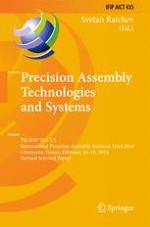
2014 | OriginalPaper | Buchkapitel
Robust Adhesive Precision Bonding in Automated Assembly Cells
verfasst von : Tobias Müller, Sebastian Haag, Thomas Bastuck, Thomas Gisler, Hansruedi Moser, Petteri Uusimaa, Christoph Axt, Christian Brecher
Erschienen in: Precision Assembly Technologies and Systems
Verlag: Springer Berlin Heidelberg
Aktivieren Sie unsere intelligente Suche, um passende Fachinhalte oder Patente zu finden.
Wählen Sie Textabschnitte aus um mit Künstlicher Intelligenz passenden Patente zu finden. powered by
Markieren Sie Textabschnitte, um KI-gestützt weitere passende Inhalte zu finden. powered by
The assembly of optical components goes along with highest requirements regarding assembly precision. Laser products have become an integral part of many industrial, medical, and consumer applications and their relevance will increase significantly in the years to come. Still economic challenges remain. Assembly costs are driven by the demanding requirements regarding alignment and adhesive bonding. Especially challenging in precision bonding are the interdependencies between alignment and bonding. Multiple components need to be aligned within smallest spatial and angular tolerances in submicron order of magnitude. A major challenge in adhesive bonding is the fact that the bonding process is irreversible. Accordingly, the first bonding attempt needs to be successful. Today’s UV-curing adhesives inherit shrinkage effects during curing which are crucial for the submicron tolerances of e.g. FACs or beam combiners what makes the bonding of these components very delicate assembly tasks. However, the shrinkage of UV-curing adhesives is not only varying between different loads due to fluctuations in raw materials, it is also changing along the storage period. An answer to this specific challenge can be the characterization of the adhesive on a daily basis. The characterization before application of the adhesive is necessary for precision optics assembly in order to reach highest output yields, minimal tolerances and ideal beam-shaping results. The work presented in this paper aims for a significantly reduced impact of shrinkage effects during curing of highly durable UV-curing epoxy adhesives resulting in increased precision. Key approach is the highly precise volumetric dispensing of the adhesive as well as the characterization of the shrinkage level. These two key factors allow most reproducible adhesive bonding in automated assembly cells. These proceedings are essential for standardized automated assembly solutions which will prospectively play a major role in laser technology.